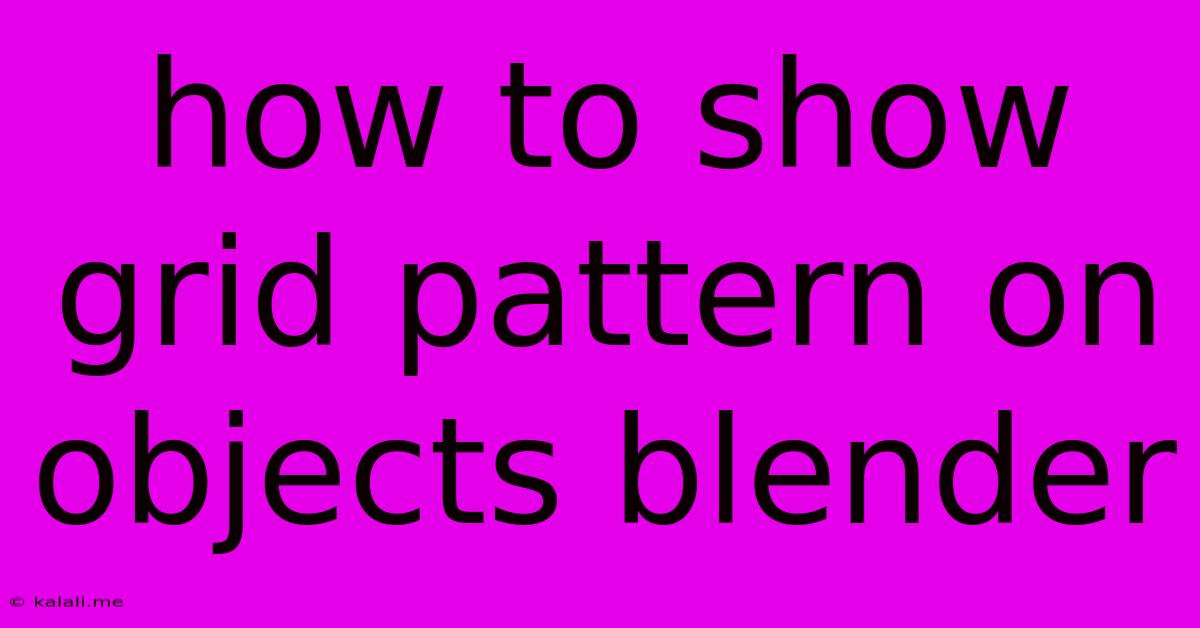How To Show Grid Pattern On Objects Blender
Kalali
May 24, 2025 · 3 min read

Table of Contents
How to Show Grid Pattern on Objects in Blender: A Comprehensive Guide
This article will guide you through several methods to display a grid pattern on your objects in Blender, enhancing your workflow and visualization. Whether you need precise measurements, want to easily understand object proportions, or simply prefer a cleaner visual representation, these techniques will be invaluable. We'll cover using modifiers, textures, and even simple tricks for achieving this effect.
Why Show a Grid Pattern?
Displaying a grid pattern on your objects offers numerous benefits for modeling and sculpting in Blender. It aids in:
- Precise Measurements and Proportions: Easily visualize and adjust dimensions.
- Improved Workflow: Faster and more accurate modeling and sculpting.
- Enhanced Visual Clarity: Better understanding of object geometry.
- Symmetrical Modeling: Ensuring even distribution of details.
- UV Unwrapping: Precisely aligning UV maps.
Method 1: Using the Subdivision Surface Modifier
The Subdivision Surface modifier is a powerful tool in Blender that can generate smooth surfaces from low-poly meshes. While not directly a grid, the smooth surface with evenly distributed subdivisions gives a grid-like appearance, particularly useful for organic modeling.
- Add Modifier: Select your object and go to the Modifiers tab. Add a Subdivision Surface modifier.
- Adjust Levels: Increase the "View" and "Render" levels to increase the subdivision density. Higher levels result in a finer, more grid-like appearance. Experiment to find the desired level of detail.
- Render: The effect will be visible in the viewport and when rendering.
Method 2: Creating a Grid Texture
This approach allows for a highly customizable grid directly on your object's surface.
- Create a New Texture: Go to the Shader Editor and create a new image texture.
- Create a Grid Image: Use an external image editor (like GIMP or Photoshop) to create a simple grid image. Save it as an image file (e.g., PNG).
- Import the Grid: Import the created grid image into the image texture node.
- Assign to Material: Connect the image texture to a material's Base Color node.
- Assign Material to Object: Assign the material to your object.
Method 3: Utilizing the "Grid" Node in the Shader Editor (Blender 3.0 and above)
This is a faster, built-in method for creating a grid texture within Blender itself.
- Create a New Material: Select your object and create a new material.
- Add a Grid Node: Add a "Grid" node to the Shader Editor.
- Connect to Base Color: Connect the "Grid" node's output to the material's Base Color.
- Adjust Parameters: Adjust the "Scale" and "Lines" parameters to control the grid's density and appearance. Experiment with the other parameters like "Offset" and "Color" to further customize.
Method 4: Using a Simple Material with a High-Contrast Color Scheme
This is a basic approach for creating a visible grid effect, ideal when you need a quick solution.
- Create a New Material: Select your object and create a new material.
- Use High-Contrast Colors: Assign a high-contrast color scheme to the material, like black and white or a dark color and light color.
- Apply to Object: Assign the material to the object. The edges and faces will be distinctly visible, creating a rough grid-like effect. This works best with low-poly meshes.
Conclusion:
Multiple methods exist to display a grid pattern on objects within Blender. The optimal approach depends on your specific needs and desired level of detail. Experiment with these techniques to find the best workflow for your projects. Remember to adjust settings for optimal visibility and accuracy based on your model's complexity and purpose. From subtle hints of structure to highly detailed grids, Blender offers the flexibility to visualize your models effectively.
Latest Posts
Latest Posts
-
How Many Apples In 3 Lb Bag
Jul 05, 2025
-
What Is Half A Quarter Of 400
Jul 05, 2025
-
How Do You Make A Vegetable Necklace
Jul 05, 2025
-
How Many 750ml Are In 1 75 Liters
Jul 05, 2025
-
How Many Grams Is In Half An Ounce
Jul 05, 2025
Related Post
Thank you for visiting our website which covers about How To Show Grid Pattern On Objects Blender . We hope the information provided has been useful to you. Feel free to contact us if you have any questions or need further assistance. See you next time and don't miss to bookmark.